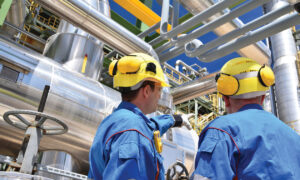Shutdown Turnaround Safety: Know the Biggest Risks and How to Avoid Them
By: Rick Pedley, Contributor
Every so often, you’ll need to shut down your facility or worksite for maintenance, whether scheduled or not. Performing maintenance, renovations, refitting or removing equipment from service is necessary in continuing a smooth and safe operation.
Like every job, there are risks associated with shutdown and turnaround processes. Employers can make some particularly dangerous mistakes and decisions where these processes are concerned, so aim to avoid these risks by planning ahead and, at the very least, communicating with your workers as soon as the process is scheduled. Managing startup, shutdown and turnaround processes may be overwhelming if viewed as a single process, so consider tackling them through a series of smaller steps. Keep the following common risks in mind along with ways to best avoid them.
Failing to Prepare
Don’t show up to work on the day of a shutdown or turnaround without knowing what’s going to happen. You should know ahead of time what equipment needs repair or replacement, and the tools and equipment to perform these tasks should be staged in advance. Establish worker responsibilities for the process, from the senior management ensuring that the processes are conducted and documented correctly to the workers performing the job. Figure out the project’s scope, the logistics of performing the work, plan for unknowns and unprecedented changes, and anything else that needs to be done before work can start up again.
Too Many Cooks in the Kitchen
Despite everyone being trained on what to do during a shutdown, the only people who should be working on the site at the time of the shutdown or turnaround should be essential to the process. Having more people around during these processes creates more risk, especially if you’re at a particularly hazardous step. The more people you have around, the more people can likely get hurt as the result of an accident. Minimize the risk by keeping everyone informed of what’s happening and when it’s taking place, and ensuring that only the essential personnel are on-site for the process.
Skipping Important Processes and Requirements
Bypassing safety devices or controls while you’re troubleshooting is asking for problems, no matter where you are in the process. Ensuring safety starts at the training and screening level, with new worker orientation and contractor review. Review OSHA and local requirements for your job and ensure that they’re fully enforced. Keep the lines of communication open as you’re working to keep everyone on the same page. Ensure that all other equipment is inspected, maintained and in proper working order and that machinery is properly grounded to minimize risks. Use your lockout and tagout equipment properly.
Prioritizing Time Over Safety
From a productivity point of view, downtime can be hard on a business. It takes time to ensure that all of the processes are properly shut down, but it’s only through grounding equipment and verifying that excess energy is released that one can properly perform the work while keeping workers safe. Don’t rush through starting back up, either—a full inspection involves ensuring that everything and everyone is clear before work can resume. Avoid rushing or cutting corners, no matter the pressure or demand, in order to prevent workplace accidents and injuries and keep your equipment working properly.
Not Documenting Processes and Changes
Senior management is responsible for ensuring that written safety reviews are followed at every stage of the process. You’ll need to review analyses of process hazards where necessary and keep them current, especially if your processes or equipment change in ways that require thinking about different hazards. A management of change analysis is also essential for equipment, processes and procedures that are different from what you had before.
Frequently review and revise your processes when necessary. If you’ve learned something new in your latest shutdown, something unprecedented happened with the new equipment during a turnaround, or some other oversight or discovery happens, writing it down ensures that other workers involved in the process are informed. Update your written records and processes and keep them accessible to everyone that’s going to be doing the work.
There may be risks on the jobsite, and not properly performing a shutdown turnaround can be one of them. These potential complications can be dangerous, especially without adequate preparation and communication. While some risks can’t be completely avoided, others can be planned around. Minimize your shutdown or turnaround risks by following your plans carefully and completely. WMHS
Rick Pedley, PK Safety’s President and CEO, joined the family business in 1979. PK Safety, a supplier of occupational safety and personal protective equipment and manufacturer of their own new FR line GRIT, has been operating since 1947 and takes OSHA, ANSI, PPE and CSA work safety equipment seriously. Speak with our safety experts at 800-829-9580 or online at www.pksafety.com/contact-us.





